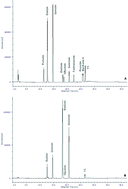Isoflavones in food supplements: chemical profile, label accordance and permeability study in Caco-2 cells
Abstract
Consumers nowadays are playing an active role in their health-care. A special case is the increasing number of women, who are reluctant to use exogenous hormone therapy for the treatment of menopausal symptoms and are looking for complementary therapies. However, food supplements are not clearly regulated in Europe. The EFSA has only recently begun to address the issues of botanical safety and purity regulation, leading to a variability of content, standardization, dosage, and purity of available products. In this study, isoflavones (puerarin, daidzin, genistin, daidzein, glycitein, genistein, formononetin, prunetin, and biochanin A) from food supplements (n = 15) for menopausal symptoms relief are evaluated and compared with the labelled information. Only four supplements complied with the recommendations made by the EC on the tolerable thresholds. The intestinal bioavailability of these compounds was investigated using Caco-2 cells. The apparent permeability coefficients of the selected isoflavonoids across the Caco-2 cells were affected by the isoflavone concentration and product matrix.


 Please wait while we load your content...
Please wait while we load your content...